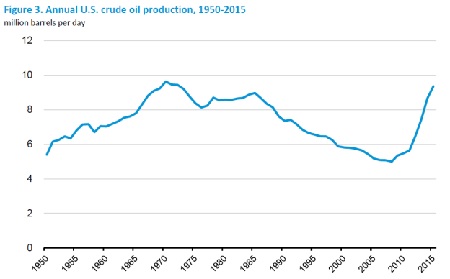The ban on crude oil exports from the U.S. is coming under increasing pressure, and a vote on lifting the ban may be held in the House this month, and in the Senate next year. Despite suggestions that lifting the ban would cause U.S. domestic gasoline prices to rise, EIA analysis suggests otherwise. Really, it’s just a political tussle between domestic oil producers and domestic oil refiners. Watch the progress of the legislation for a sense of which side will win -- and profit.
U.S. Oil Producers and Refiners Prepare For Battle in Congress
With the renaissance of U.S. oil production inaugurated by new technologies to access tight oil, the debate has again arisen about removing the ban that prevents crude oil from being exported by the U.S. -- a ban that originated in the 1970s during the OPEC oil crisis. That debate has gotten hotter, with the House likely to vote by the end of this month on ending the ban, and the Senate likely to take it up next year.
Fracking Technologies Have Revolutionized U.S. Oil Production
Source: EIA
Last week, the Energy Information Administration (EIA) published a comprehensive report on the effects of lifting the ban. Opponents often suggest that lifting the ban would be bad for U.S. consumers, because it would cause domestic gasoline prices to rise. However, the EIA’s analysis disagrees, and contradicts the position of the Obama administration. The report states:
“Petroleum product prices in the United States, including gasoline prices, would be either unchanged or slightly reduced by the removal of current restrictions on crude oil exports. As shown in a previous EIA report (What Drives U.S. Gasoline Prices?, October 2014) petroleum product prices throughout the United States have a much stronger relationship to Brent prices than to WTI prices. In the high production cases considered in this study… the elimination of current restrictions on crude oil exports narrows the Brent-WTI spread by raising the WTI price. As domestic producers respond to the higher WTI price with higher production, the global supply/demand balance becomes looser unless increased domestic production is fully offset by production cuts elsewhere. The looser balance implies lower Brent prices, which in turn results in lower petroleum product prices for U.S. consumers.”
That has been the conclusion of EIA analysts for some time. But a little later in the report, it becomes clearer where the opposition to lifting the ban is really rooted:
“Refiner margins (measured as the spread between crude input costs and wholesale product prices), which tend to increase as the Brent-WTI spread widens, would be lower without current restrictions on crude oil exports than with them in high-production cases where export restrictions lead to a widening Brent-WTI spread. If domestic crude oil production reaches a level where current restrictions on crude oil exports result in a need for significant additional processing capacity to convert domestic crude into petroleum products that can be exported, the discount of domestic crude prices compared with global crudes such as Brent will widen to encourage investment in such capacity, notwithstanding the risk of future changes in crude oil export policy or market conditions. For owners of existing refinery capacity, a wider Brent-WTI spread will provide higher margins as refined product prices continue to move with global crude prices. In high-production cases, the removal of export restrictions limits growth of the Brent-WTI spread, limiting growth in refining margins. However, even with the removal of export restrictions, the projected Brent-WTI spread would still be higher than its average level in 2014. For upstream oil producer margins, the opposite prevails – in addition to an increase in production in cases where unrestricted crude oil exports result in higher domestic prices, production that would occur with or without a change in crude oil export policy is more profitable with domestic wellhead prices that are not held down by crude oil export restrictions.”
In short, although the issue is often presented politically as one related to national security (“we shouldn’t export a scarce and critical resource”), the maneuvering underlying the debate is more mundane. Domestic oil producers are against the ban, because lifting it will reduce the spread between domestic and global crude oil prices. Domestic refiners are for the ban, because they want their inputs to stay cheaper, even while their products are largely priced in-line with global crude prices.
Although there are many caveats, and oil is complex to analyze, the EIA reports make a good case that fearmongering about domestic gasoline prices is significantly overdone.
Investment implications: The ban on crude oil exports from the U.S. is coming under increasing pressure, and a vote on lifting the ban may be held in the House this month, and in the Senate next year. Despite suggestions that lifting the ban would cause U.S. domestic gasoline prices to rise, Energy Information Administration analysis suggests otherwise. Really, it’s just a political tussle between domestic oil producers and domestic oil refiners. Watch the progress of the legislation for a sense of which side will win -- and profit.

